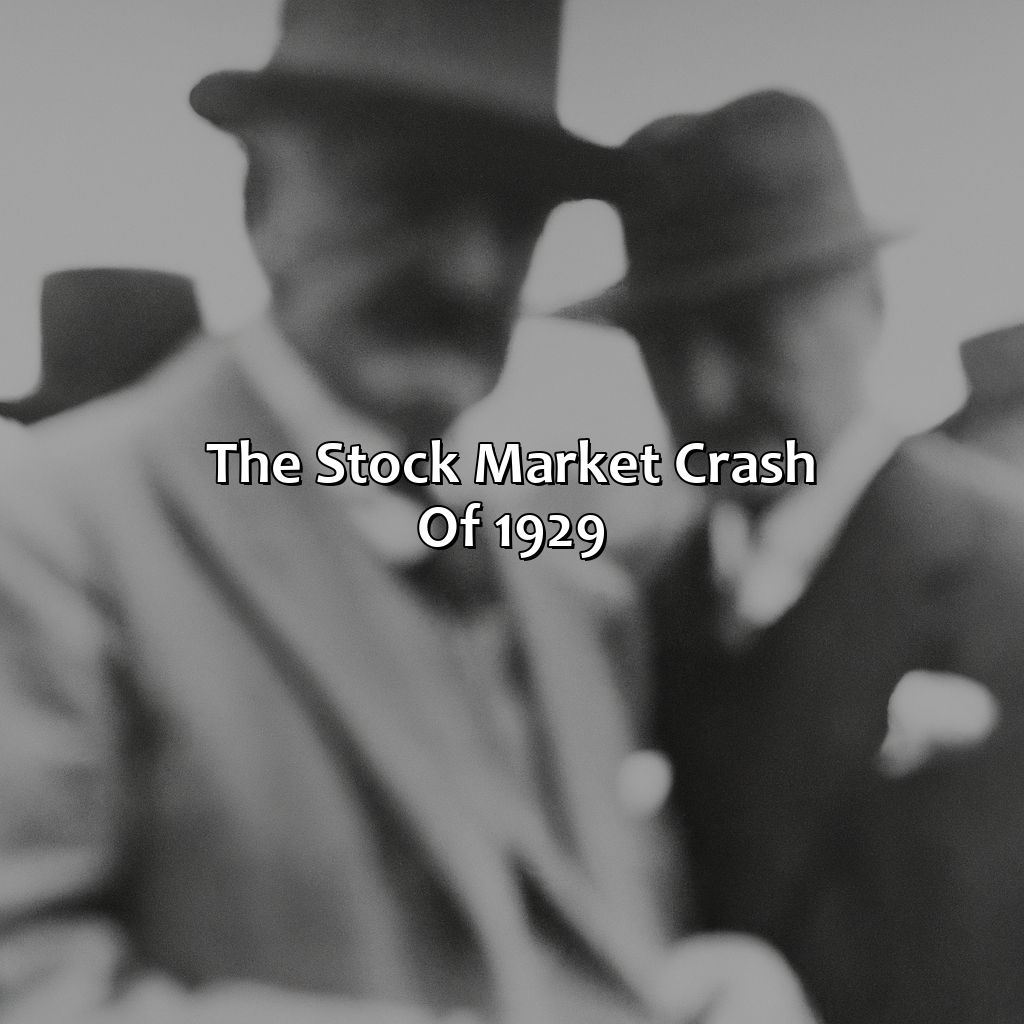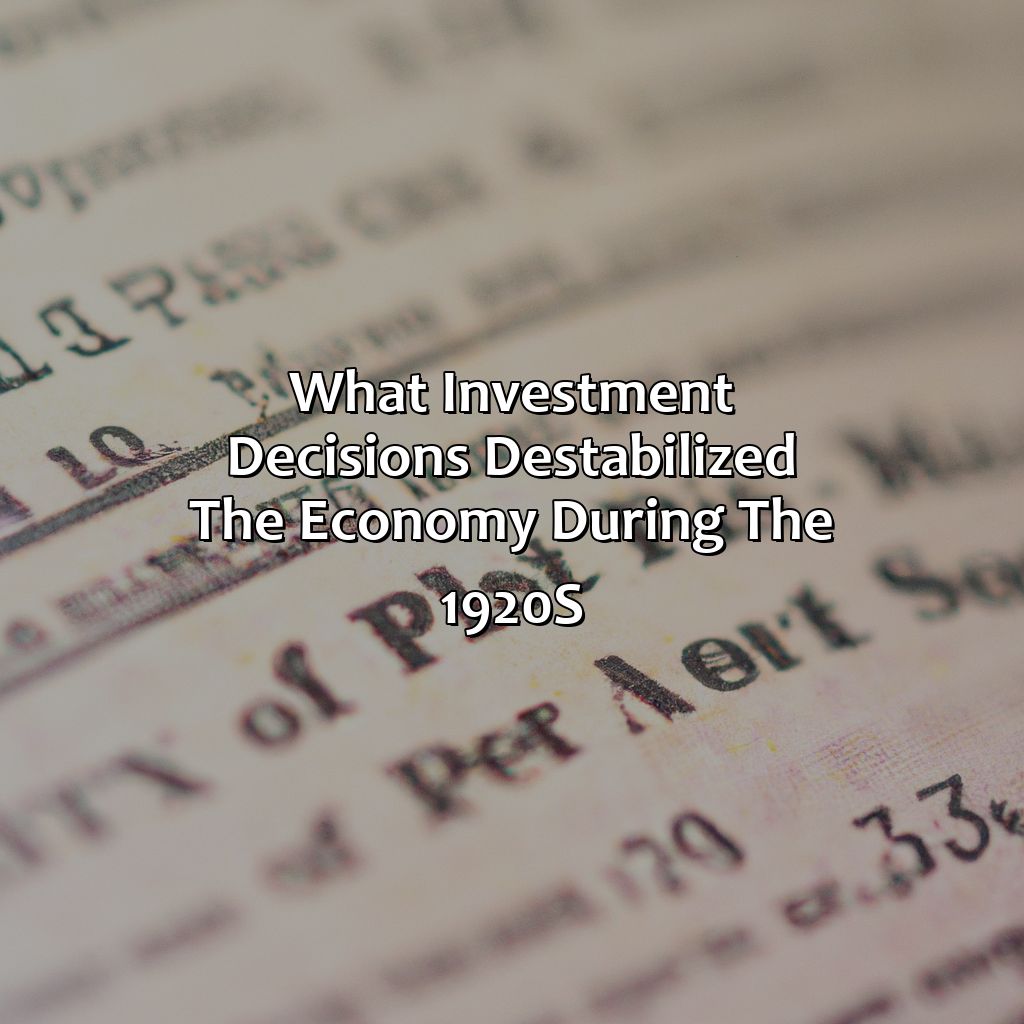What Investment Decisions Destabilized The Economy During The 1920S?
Key Takeaway:
- Over-speculation and Margin Trading: The stock market crash of 1929 was partly fueled by over-speculation and margin trading which led to inflated stock prices and ultimately caused the market to crash.
- The Role of Investment Trusts: Investment trusts, which allowed individuals to invest in a variety of companies, also contributed to the destabilization of the economy in the 1920s. Many investment trusts invested heavily in the stock market, and when the market crashed, these trusts also suffered major losses.
- The Agricultural Depression: The expansion of farming and overproduction, coupled with the reduction of global demand for agricultural products, contributed to the economic instability of the 1920s. This led to a decrease in profits for farmers, which led to a decrease in spending and ultimately hurt the economy as a whole.
Are you wondering why the economy destabilized during the 1920s? Investing decisions made by individuals and corporations alike were largely to blame. This article looks at the factors that contributed to the economic downturn. You’ll learn how to avoid making the same mistakes in the future.
The Stock Market Crash of 1929
To grasp the cause of the Stock Market Crash in 1929, let’s study two factors: over-speculation and margin trading. Plus, let’s explore the part played by investment trusts.
These subsections will explain the investment choices made during the 1920s which made the economy unsteady. This eventually led to the cataclysmic crash of 1929.

Image credits: retiregenz.com by Yuval Woodhock
Over-speculation and Margin Trading
Investors’ overindulgence in stock speculation and borrowing money to invest were major factors contributing to the Stock Market Crash of 1929. Excessive trading on margin led to massive loans, which aggravated the already unstable market conditions. This resulted in a collapse that affected not only Wall Street but also global economies. The use of leverage to purchase stocks had become so rampant during the 1920s that many investors even used their life savings as collateral.
Furthermore, investors had unrealistic expectations about profits and growth, leading them to speculate on companies with unproven track records or overinflated valuations. Many bought stocks simply because they heard others talking about them or because they believed rumors unsupported by any real evidence.
Notably, these over-speculation trends were accompanied by inadequate government regulation, untimely responses from banking officials, and a lax attitude among business elites toward potential financial instability.
Such exuberance could not be maintained, and in late October 1929, Black Tuesday hit Wall Street when the market experienced one of the most significant declines in history. Within a week’s time, more than $30 billion dollars had evaporated from values equivalent to roughly half of America’s national income at the time. This collapse shook investor confidence and triggered an economic depression that lasted throughout the next decade.
If you thought trust was important in a relationship, just wait until you hear about the role of investment trusts in the stock market crash of 1929.
The Role of Investment Trusts
Investment trusts played a significant role in the stock market crash of 1929. These trusts were investment vehicles that pools together funds from various investors to invest in stocks. The rising popularity of investment trusts during the 1920s led to increased speculation and over-investment, leading to disproportionate increases in stock prices.
This trend continued until early September 1929 when many investment trusts struggled to meet redemption requests from investors. As a result, the market was flooded with stocks that could not be sold, causing the prices to plummet, triggering the infamous stock market crash of 1929.
Furthermore, Investment Trusts were also interconnected through banks and brokerages creating a complex web of financial dependency. When one Trust fell into financial trouble after being wiped out by the stock market crash, it often caused several others to fail as well.
Ultimately, The Role of Investment Trusts offers valuable insight into how over-speculation, where people buy more than they can afford hoping for quick returns without considering whether they can cover their debts later on or not played an important role in destabilizing the US economy during the 1920s.
Why did the chicken cross the road during the Agricultural Depression? To invest in corn!
The Agricultural Depression
To comprehend the economic destabilization in the 1920s, investigate ‘The Agricultural Depression’ section. This will provide insight on the expansion of farming and overproduction. Another key factor to consider is the reduction in global demand for agricultural products.

Image credits: retiregenz.com by Yuval Jones
The Expansion of Farming and Overproduction
During the 1920s, there was a significant increase in agricultural productivity due to the expansion of farming and overproduction. This led to an imbalance between supply and demand, causing prices to fall and consequently destabilizing the economy. Farmers continued to produce more crops even though they were not receiving satisfactory returns for their efforts.
As a result of this overproduction, food prices declined drastically, significantly lower than the cost of production. The subsequent decrease in demand resulted in farmers being unable to sell their produce at a profit. In some cases, farmers were ultimately forced to destroy their crops because they could not afford to transport them or pay storage fees.
In addition, advancements in technology contributed to the increased productivity, such as tractors replacing horses and plows. Farmers borrowed significant amounts of money for these technologies which increased debt burdens and compounded the issue further.
To address this instability, policymakers implemented New Deal programs such as price supports and subsidies to stabilize farm income by raising crop prices artificially. These programs managed volatility but did not eliminate oversupply or frequently low-income levels.
Investors should account for unavoidable fluctuations in commodity markets when investing in agriculture’s value chain. They should also consider efficient ways of reducing costs such as streamlining operations or adapting alternative methods for increasing productivity while prioritizing sustainability goals.
Looks like farmers were in desperate need of a marketing team, because the world just wasn’t buying what they were selling.
The Reduction of Global Demand for Agricultural Products
The decrease in the global appetite for agricultural products severely impacted the economy during the 1920s. This downturn was partly due to overproduction, leading to a situation where supply outstripped demand, ultimately reducing prices and causing financial losses for farmers and investors alike.
This phenomenon affected not only the United States but also various countries across Europe and beyond, as urbanization led to a reduction in the total number of agricultural workers, resulting in an overall decline in demand. Despite efforts to rectify this trend by implementing new technologies and cultivating new markets, it took many years before demand stabilized and prices rebounded.
One unique aspect of this depression was its effect on rural communities. While cities had manufacturing industries that could provide alternative employment opportunities, many small towns with economies based solely on agriculture suffered immensely during this period. Many people left these areas in search of better opportunities elsewhere, exacerbating the issue further.
A real-life example of how this cycle played out involved a family marred by investments in agriculture during the boom years of production. The Hicks family had owned land for generations which they leased out for corn growth. Leveraging the success from their estate investment portfolio enabled them to purchase machinery and fertilizers for expanding their farms operations magnitude. However, when prices collapsed due to overabundance had decreased market value on crops and weakened consumption internationally – they were forced into bankruptcy within several seasons.
Five Facts About Investment Decisions That Destabilized The Economy During the 1920s:
The stock market bubble of the 1920s was fueled by speculative investments and margin buying. (Source: Investopedia)
Banks made risky loans to investors in an effort to profit from the stock market boom. (Source: History.com)
The Federal Reserve’s policies of low interest rates and easy credit contributed to the economic instability of the era. (Source: Forbes)
The Smoot-Hawley Tariff Act, which raised import duties on foreign goods, contributed to the onset of the Great Depression. (Source: History.com)
The lack of government regulation and oversight of the financial industry allowed for fraudulent practices and contributed to the economic instability of the era. (Source: The Balance)
FAQs about What Investment Decisions Destabilized The Economy During The 1920S?
What investment decisions destabilized the economy during the 1920s?
Several investment decisions played a role in destabilizing the economy during the 1920s, including:
- Huge investments in the stock market, which created a bubble that eventually burst
- Speculative investments in real estate, which led to overbuilding and a subsequent crash
- Excessive borrowing and lending by banks and individuals, leading to debt that couldn’t be repaid
- Investments in new industries and technologies that had not yet proven profitable, leading to a lack of return on investment
- Overproduction by industries, which led to a decrease in prices and profits
- Investment in overvalued assets, such as gold and foreign currencies, which led to unwillingness to invest in more stable assets.
 Checkout this IRS Loophole
Checkout this IRS Loophole 
